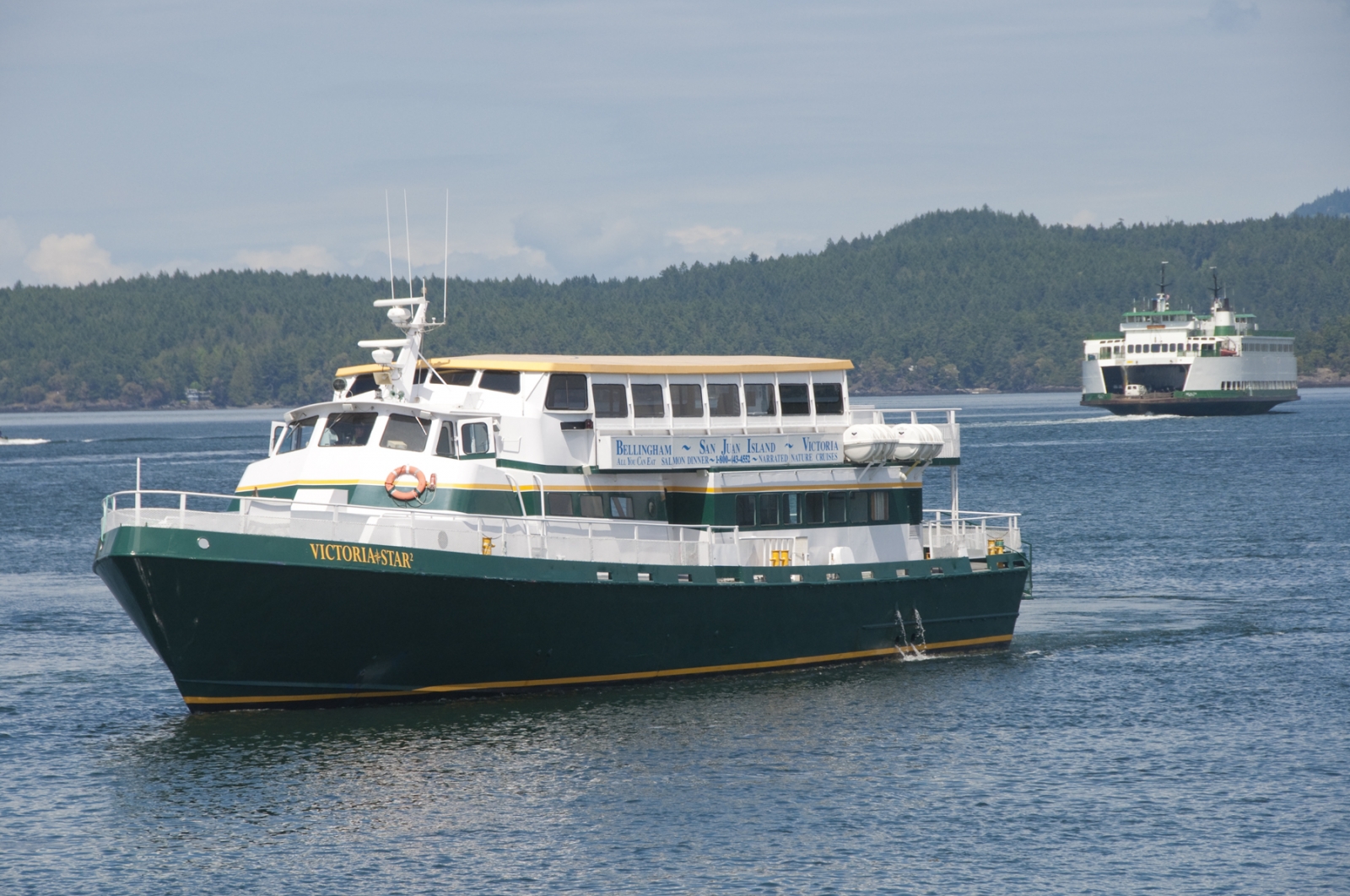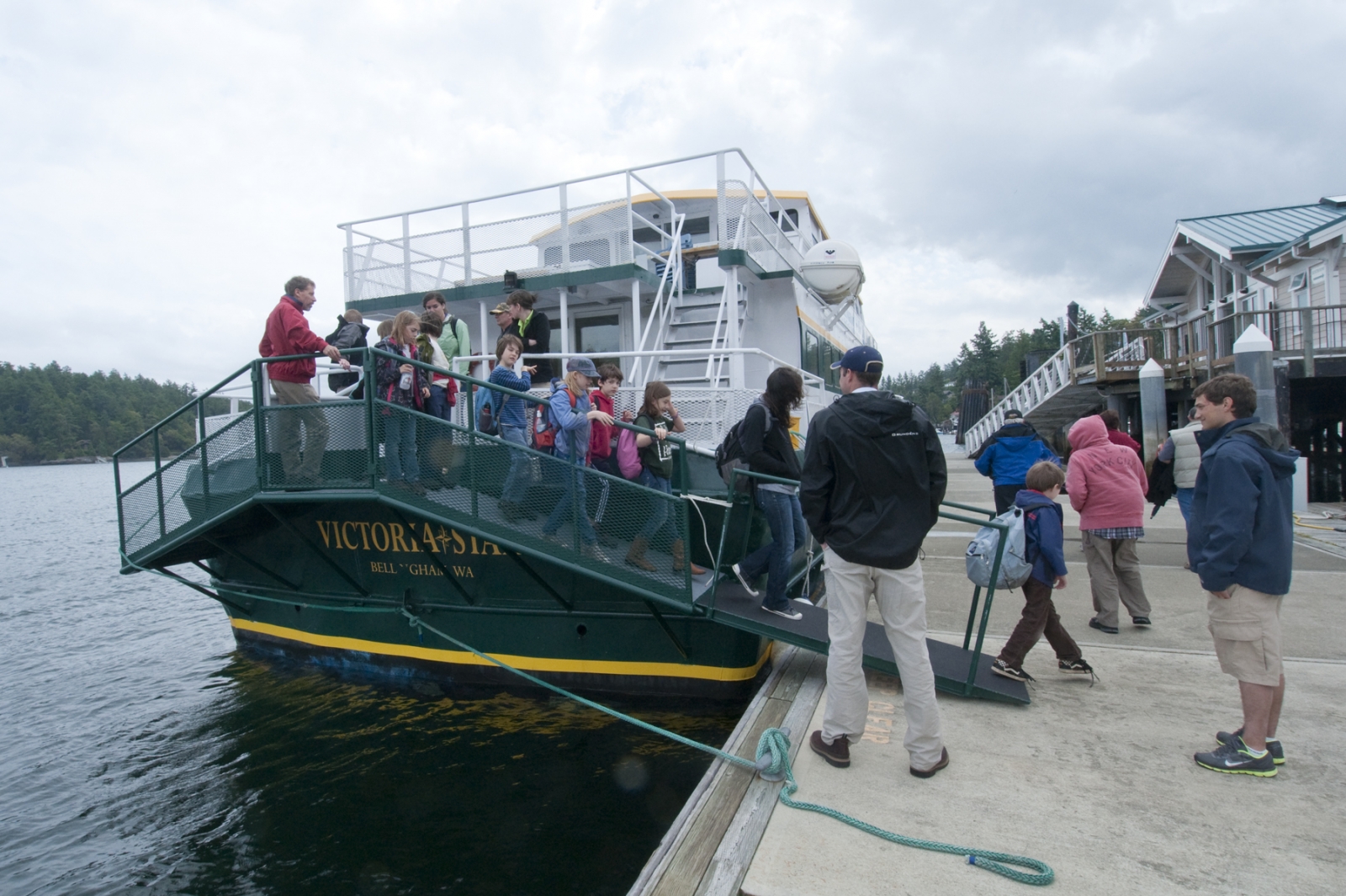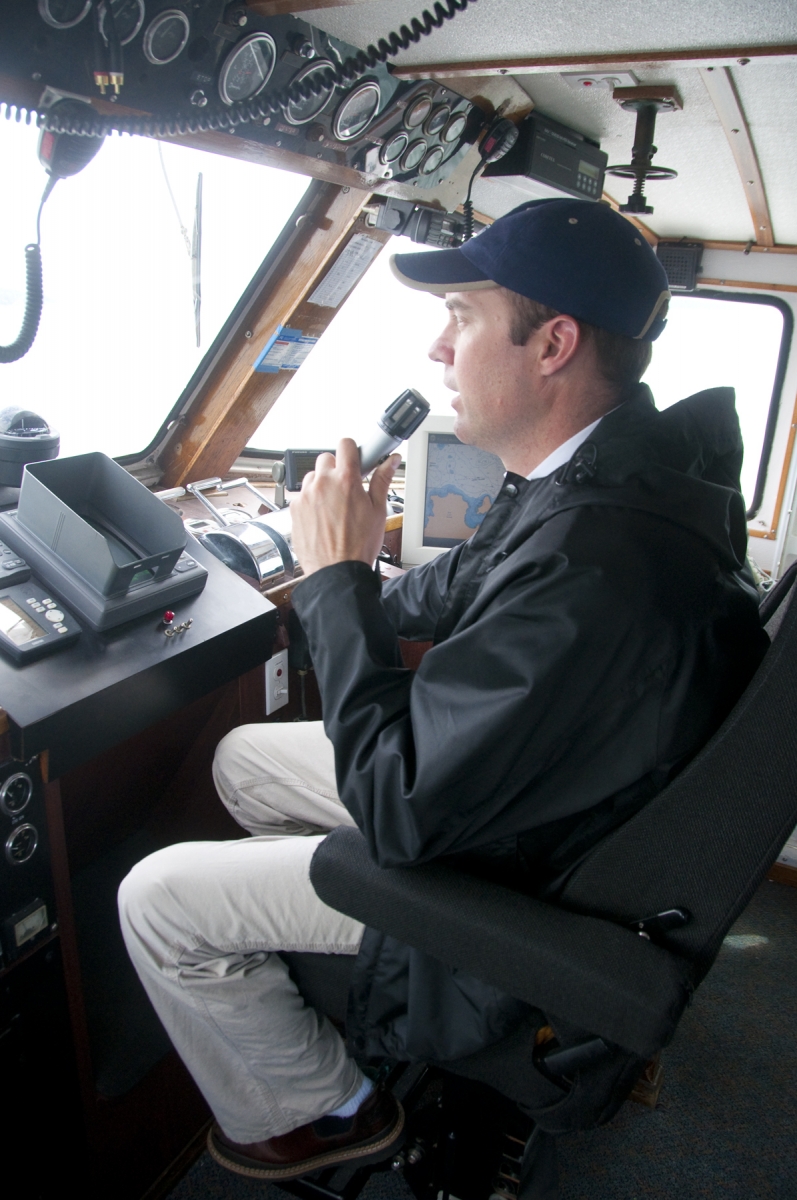The crew on Victoria Star gives a whole new meaning to the term "cook/deck hand." On some workboats the term means mediocre meals served by reluctant recruits. But Victoria Star earns its keep carrying up to 149 passengers on tours through the spectacular tree-covered San Juan Islands in Washington's Puget Sound.
 |
|
Victoria Star is a 100-foot former Gulf of Mexico crew boat that was converted to a tour boat with the capacity for up to 149 passengers. (Alan Haig-Brown photo) |
Day trips include an impressive salmon and chicken buffet, and evening trips generally dish up a crab bake of local Dungeness crab. All of this is cooked on board in a well-equipped galley located a few steps down in the forecastle and accessible from behind the food bar.
On a recent trip, the former Gulf of Mexico crew boat departed its Bellingham, Wash., base next door to the Alaska ferry terminal with a relatively light load of passengers who included several tourists and an elementary school class on a field trip. The three deck hands, Nick Westergreen, Tim Rapoza and Rachel Wood, assisted the passengers with boarding and welcomed them aboard.
Promptly at 0930, under the direction of Senior Capt. Grant Bird, the crew let go the mooring lines. The boat's three 12 V-71 Jimmies eased up to a fuel efficient operating speed of about 1,500 rpm to give the boat a comfortable cruising speed of around 15 knots. This leaves some extra rpm to make up the schedule if required.
Owner of Victoria Star and two other vessels, Drew Schmidt bought the boat in 1995, then named Renna G, from a San Diego owner. At some point a very nicely designed set of passenger accommodations was added to give two decks of comfortable seating at booth-style tables. Forward in the main deck seating area, a snack bar provides drinks and sandwiches throughout the cruise.
 |
|
Passengers disembarking at Friday Harbor, a town of 1,500 on the east side of the San Juan Islands. (Alan Haig-Brown photo) |
For the day cruise, the 100-by-24-foot vessel takes a meandering course, threading its way through some of the San Juan group's 172 islands. Only about 60 of these are inhabited. Others are too small, lack water or are in nature preserves. The cruise then heads south across Bellingham Bay and rounds the bottom end of Lummi Island to enter Rosario Strait.
On this day, Capt. Bird, comfortable in his pilot's chair, used the PA system to give bits of human and natural history to the passengers in the separate accommodation areas. "We are passing Vendovi Island, named for Ro Veidovi, who was taken prisoner in the Fiji Islands by the Wilkes Expedition."
The Wilkes Expedition was an early foray into world exploration by the United States between 1838 and 1842. The expedition traveled from Norfolk, Va., to the South Pacific where its members took part in a number of bloody conflicts, called massacres by some. It was just prior to one of these that Veidovi, a Fijian chief, was captured.
Bird explained that Veidovi had earned much respect among the crew of the expedition but was later taken to New York where he died. The 217-acre island was recently bought and protected from development by the San Juan Preservation Trust.
 |
|
Capt. Dale Jemson, who normally is master of a smaller tour boat, practices docking Victoria Star at Friday Harbor while Capt. Grant Bird watches from the deck. (Alan Haig-Brown photo) |
Bird, who learned his work ethic growing up on a cattle ranch in eastern Washington, had been a commercial fisherman and passenger vessel operator in Alaska before coming south to work for San Juan Cruises 15 years ago. Now, with a wife and young daughter, he likes the work that gets him out on the water but home every night. Better yet, unlike his time spent winter long-line fishing, the tour boats only work in the summer months. (Schmidt keeps his senior staff employed by doing all the vessel maintenance in-house over the winter months.)
In addition to Victoria Star, the company, San Juan Cruises, operates two other vessels: the 49-passenger Viking Star and the 48-foot Island Commuter.
Viking Star has a regular three-day trip around the San Juans that utilizes a hotel in Friday Harbor on San Juan Island for the overnight accommodation. It seems that the firm's success lies in matching vessels with the job and cruises with customer demand.
For years the company operated a very successful day cruise to Victoria, British Columbia, with Victoria Star. Unfortunately heightened border security has required all passengers to carry passports. Since about 70 percent of Americans don't have passports, this regulation caused sharp declines in bookings. The cruise through the islands with a midday stop in Friday Harbor is being offered this year, as it doesn't require a passport.
Whale watching is a major attraction in the Pacific Northwest. While the possibility of seeing whales is a significant part of the marketing, the onboard commentary is quick to explain that this is a possibility, not a certainty. Cooperation between some 30 whale-watch firms on both sides of the Canada-U.S. border dramatically increases the opportunity. Boats on both sides of the Strait of Juan de Fuca relay sightings to a central dispatcher in Victoria, who collects reports of sightings from the members. These are then relayed by text.
 |
|
Capt. Bird uses the public address system while conning Victoria Star. During the course of the trip, Bird provides passengers with commentary about the human and natural history of the islands. (Alan Haig-Brown photo) |
As Victoria Star came down Rosario Strait past Decatur Island, Bird explained, "Rosario Strait can get lumpy, so we have four of five different channels that we can take to avoid that if it is blowing."
On this day Rosario was calm, but the fast-flowing ebb in the strait set up a strong tide line where the fast water met the slower moving waters of the eastern end of the Strait of Juan de Fuca. Pointing this out to his passengers, Bird explained that 12-foot tides were not uncommon in these waters. He also directed their attention to tiny Colville Island off the southern tip of Lopez Island, where a number of harbor seals had hauled out to take advantage of the morning sun. There was also a residual ocean swell pushing in from Juan de Fuca.
Turning north up along the outside of Lopez Island, the boat developed a gentle movement with the swell and Bird went on the PA to assure the passengers that they would soon be in more sheltered waters. At the same time, an hour and 45 minutes after leaving the dock, he noted the whale-watch catamaran Victoria Clipper III out of Seattle coming up to port and the smaller Port Townsend-based whale watcher Glacier Spirit up ahead.
A call came from the smaller boat asking if there had been any whale sightings. Bird replied in the negative before making the turn to follow Glacier Spirit past Cattle Point Lighthouse on the southern tip of San Juan Island and into the pass, with the same name, between San Juan and Lopez islands.
The swells disappeared in the more sheltered waters as the skipper told his passengers the story of the Pig War between the Americans and British over ownership of the San Juan Islands. The dispute lasted for 13 years in the late 19th century, with the only casualty being a British pig caught rooting in an American's garden.
While Bird was explaining all of this, his crew of three cook/deck hands were busy serving up snacks and drinks to the passengers and explaining other bits of the passing scenery. By 1200, two and a half hours after leaving Bellingham, Victoria Star was approaching Friday Harbor, a town of 1,500 people on the east side of San Juan Island. The passengers would have two hours for shopping and sightseeing on the island, but first they were entertained with a further anecdote from the Wilkes expedition. Apparently a group of the crew was out in a longboat surveying the area. When a fog set in and they found themselves lost in this harbor, they called out across the waters to a local fisherman, "What bay is this?"
But the fisherman, misunderstanding, replied, "It is Friday."
The name was duly recorded on the new charts.
The Port of Friday Harbor is an immaculate home to a large number of pleasure craft. It also has a Washington State car ferry landing and a well-put-together float for offloading passengers. As Glacier Spirit had already reached the dock, Victoria Star waited her turn. Once at the dock, the cooks became deck hands again and quickly secured the mooring lines before securing the stern-mounted gangway for the passengers.
Once all the passengers were ashore, the vessel moved off the dock to make way for other whale-watch boats to land passengers. On this voyage, Capt. Dale Jemson, who normally runs the 49-passenger Viking Star, was along for cross training on operation of the larger Victoria Star. He and Capt. Bird took the boat over to a floating breakwater and practiced landings.
As a typical Gulf of Mexico crew boat, the aluminum-hulled vessel has a relatively flat bottom and shallow draft. This, combined with the additional superstructure's windage, can take a bit of getting use to. But Jemson was soon walking the boat sideways and making near perfect landings. At the same time, the cook/deck hands were busy in the main cabin thawing 70 Dungeness crab halves. These would be baked for a special charter trip that the boat would make that evening. Asked if he was a trained chef, Rapoza explained that he had learned over the several years that he has worked on the cruise, but he sees his future in the wheelhouse rather than the galley.
Not only were the three cook/deck hands thawing the crabs, they also had a buffet dinner of chicken and baked salmon in the galley ovens. When the passengers came back aboard after their tour of Friday Harbor, Victoria Star left the dock at 1445. Capt. Jemson checked in with Seattle Vessel Traffic Service on the VHF to tell them that the boat would be returning to Bellingham through Obstruction Pass.
With an ETA for Bellingham of 1730, the crew got the buffet set out for the passengers, who quickly settled into a pleasant meal as wooded shores passed by their windows. When they offloaded promptly at 1730, the passengers seemed well satisfied with the spectacular scenery and with the food served by the cook/deck hands.
